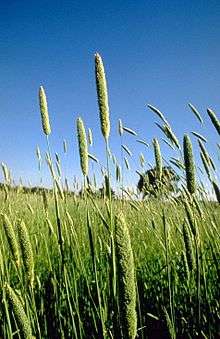Phalaris aquatica
| Phalaris aquatica | |
|---|---|
 | |
| Scientific classification | |
| Kingdom: | Plantae |
| (unranked): | Angiosperms |
| (unranked): | Monocots |
| (unranked): | Commelinids |
| Order: | Poales |
| Family: | Poaceae |
| Genus: | Phalaris |
| Species: | P. aquatica |
| Binomial name | |
| Phalaris aquatica L.[1] | |
Phalaris aquatica (syn. P. tuberosa) known by the common names bulbous canary-grass[2] and Harding grass, is a species of grass in the genus Phalaris of the Poaceae Family.
Description
It is an erect, waist-high, stout perennial bunch grass with grayish to bluish green leaves. Flowering heads are dense, spike-like, and usually two to five inches long. It is slow to develop from seed, but can form large bunches after several years.[3]
Phalaris arundinacea (reed canary grass) differs from Harding grass in having more distinct rhizomes and an inflorescence that is compact at first but later becomes more open as the branches spread.
Hybrids of Harding grass and reed canary grass have been produced. Varieties include 'AQ1', 'Uneta', and 'Australis'.
Toxicity
Some Phalaris species contain gramine, which can cause brain damage, other organ damage, central nervous system damage and death in sheep[4] although Phalaris aquatica is said to be non-toxic.[5]
Leaves and seedlings contain the tryptamine hallucinogens DMT, 5-MeO-DMT and related compounds.[6] A raw, dried plant Phalaris aquatica contains approximately 0.1% DMT, 0.022% 5-MeO-DMT, and 0.005% bufotenin.[7] A particular strain of P. aquatica from Italy, labeled 'AQ-1', was reported to contain in excess of 1.0% alkaloid concentration.[8]

Invasive species
Harding grass is an invasive species in grassland, oak woodland, chaparral, and riparian habitats. Native grasses and grassland habitat in California are affected.
See also
- Psychedelic plants
- Invasive grasses of North America
- Invasive plant species
References
- ↑ "Phalaris aquatica information from NPGS/GRIN". www.ars-grin.gov. Retrieved 2008-04-02.
- ↑ "BSBI List 2007" (xls). Botanical Society of Britain and Ireland. Retrieved 2014-10-17.
- ↑ ucce.ucdavis.edu
- ↑ Toxicants of Plant Origin - Google Book Search. books.google.com. Retrieved 2008-04-20.
- ↑ http://www.regional.org.au/au/asa/1996/contributed/450oram.htm
- ↑ Tryptamine Carriers FAQ
- ↑ Phalaris / DMT FAQ
- ↑ Phalaris: Some of the many strains of interest.
| Wikimedia Commons has media related to Phalaris aquatica. |